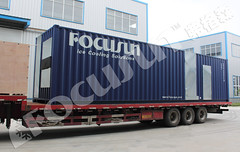
- Get More Information Here:
- Air Cooled Water Chillers System
Consider the following usual methods of ventilation cooling:* Exhaust fans or Power Roof Ventilators (PRVs). To do a satisfactory job of eliminating excessively hot air, it is usually essential to have powered wall and/or roof exhausters. These fans should also help to control air pressure within the building whether it be negative or positive pressure.* Supply Fans or PRVs. A large number of buildings use exhaust PRVs to exhaust fumes, smoke, dust or other contaminants unavoidable in the operation of the business. As a result, these buildings are frequently under a severe negative pressure. The solution to the problem of this kind is usually found in the use of supply fans or “make-up” air ventilators.* Air Circulators. If the exhaust and supply air requirements of a building have been carefully engineered and installed, and there continues to be a high instance of worker discomfort, the problem usually relates to the matter of air circulation. In this way, in addition to amximum benefit from the fresh, cooler air, occupants receive the added comfort of air circulation over their bodies and they are not adversely affected by the superheated air being exhausted from the building.American Blowers Co. offer quite a few techniques of efficient building ventilation and cooling. In industrial plants where there is a high density of employees and many manual operations involved, an improvement in the environment can produce substantial benefits in terms of increased production, reduced errors, and a decline in complaints and absenteeism among employees. In other circumstances, the attentiveness of an audience or student group may be a factor that spells success or failure for the project.To obtain a reasonable degree of personnel comfort in hot weather, there are three basic factors that should be provided for in the ventilation and coolong system of a commercial or industrial building.REMOVAL OF EXCESSIVELY HOT AIRThe first step toward controlling the hot air porblem is to provide for the removal of excessively hot air from the building. This superheated air frequently mixes with the air in the cooler areas of the building to produce an overall temperature increase. As superheated air is frequently localized around heat-producing machinery, it should be exhausted from the building near its source.SUPPLY COOLER AIRAs a rule, outside air temperatures are considerably cooler than those inside a building. As superheated air is exhausted, provision should be made to replace it with fresh, cooler, outside air. When high temperature air is replaced by outside air, a substantial improvement in the average ait temperature of the building results. Even where outside air temperature may be in the 80s or 90s, invariably it is 15 degress to 20 degrees cooler than the air it replaces. This is a very important improvement to the individuals affected ventilating.com fanblower.com highpressureblower.net industrialblowerfan.com industrialfanblower.net industrialfanblower.com pressureblower.net northernindustrialsupplycompany.com industrialpressureblower.com tenderall.com chicagoblowercanada.com cbblower.com buffaloblower.com buffalofan.com nis-co.com canadianblower.com olegsystems.com canadablower.com abbblower.com acmefan.net industrialblower.net fansandblowers.net americanblower.net barryfan.com cincinnatifan.net canadafans.com barryfan.net pennbarry.net pennfan.net tcffan.com.VENTILATIONA very effective way to overcome the discomfort of a hot, stuffy room is to create a breeze. The circulation of air over a person’s body immediately causes a cooling effect on the skin. When air is passed over a moist surface, it will evaporate some of the moisture and thus lower the temperature of the surface. This is precisely what occurs when air circulates across the human body. By creating a gentle breeze throughout a room or area, a great deal of cooling comfort is provided for individuals who must work there. This pattern of air circulation is sometimes called “breeze conditioning”.For additional information please refer to http://www.americanblower.net/axial.htmlSusanna TerlitskaiaIndustrial Ventilating EngineerAmerican Blowers Companynis@primus.cahttp://www.americanblower.net/rfq.htmlhttp://www.americanblower.net/PressureBlowers.html